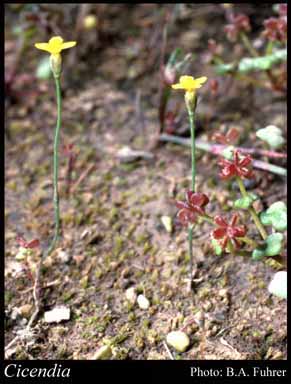- Reference
- Fam.Pl. 2:503 (1763)
- Name Status
- Current







Scientific Description
Common name. Cicendias. Family Gentianaceae.
Habit and leaf form. Herbs. Annual. Leaves basal and cauline. Plants with a basal concentration of leaves; to 0.15–1.3 m high. Mesophytic. Heterophyllous. Leaves small; not fasciculate; opposite; decussate; not decurrent on the stems; ‘herbaceous’; not imbricate; sessile; simple; epulvinate. Leaf blades dorsiventral; entire; flat; basal and stem leaves linear, or ovate (in stem leaves), or obovate (in basal leaves). Mature leaf blades adaxially glabrous; abaxially glabrous. Leaves without stipules. Leaf blade margins entire. Leaves without a persistent basal meristem. Leaf anatomy. Hairs absent. Roots. Aerial roots absent.
Reproductive type, pollination. Fertile flowers hermaphrodite. Unisexual flowers absent. Plants hermaphrodite. Plants homostylous. Floral nectaries absent. Entomophilous.
Inflorescence and flower features. Flowers solitary, or aggregated in ‘inflorescences’; terminal (when solitary). Inflorescence few-flowered. Flowers in cymes. The terminal inflorescence unit cymose. Inflorescences terminal; usually a simple or compound dichasium. Flowers pedicellate; small; regular; 4 merous; tetracyclic. Free hypanthium absent. Perianth with distinct calyx and corolla; 8; 2 -whorled; isomerous. Calyx present; 4; 1 -whorled; gamosepalous; lobed; lobulate. Calyx lobes markedly shorter than the tube. Calyx glabrous; usually imbricate; exceeded by the corolla; campanulate; regular; green; persistent. Calyx lobes triangular. Corolla present; 4; 1 -whorled; appendiculate; gamopetalous; lobed; lobulate. Corolla lobes markedly shorter than the tube. Corolla contorted; rotate, or urceolate; regular; glabrous abaxially; glabrous adaxially; plain; yellow; persistent. Corolla lobes ovate. Corolla members entire. Androecial members definite in number. Androecium 4. Androecial members adnate (basally to the corolla tube); all equal; free of one another; 1 -whorled. Stamens 4. Staminal insertion near the base of the corolla tube. Stamens all inserted at the same level; all more or less similar in shape; isomerous with the perianth; all alternating with the corolla members; erect in bud. Anthers all alike; basifixed; non-versatile; dehiscing via longitudinal slits; tetrasporangiate. Fertile gynoecium present. Gynoecium 2 carpelled. The pistil 1 celled. Gynoecium syncarpous; synstylovarious to eu-syncarpous; superior. Ovary unilocular; 1 locular. Gynoecium median; stylate. Styles 1; attenuate from the ovary; apical; deciduous; hairless. Stigmas 1; 2 - lobed; capitate. Placentation parietal. Ovules in the single cavity 100 (i.e. ‘many’).
Fruit and seed features. Fruit 2–4 mm long; non-fleshy; not hairy; dehiscent; a capsule. Capsules septicidal. Dispersal unit the seed. Fruit 30–50 seeded (‘many’). Seeds endospermic; minute. Cotyledons when developed, 2. Embryo straight.
Geography, cytology, number of species. World distribution: cosmopolitan. Adventive. Australian states and territories: Western Australia, South Australia, New South Wales, Victoria, Australian Capital Territory, and Tasmania. South-West Botanical Province. 2n = 26 in all species. A genus of 2 species; 2 species in Western Australia.
Etymology. Based on the name recorded by Dioscorides and supposedly from ancient Tuscany for an unknown plant of the family.
Taxonomic Literature
- Wheeler, Judy; Marchant, Neville; Lewington, Margaret; Graham, Lorraine 2002. Flora of the south west, Bunbury, Augusta, Denmark. Volume 2, dicotyledons. Australian Biological Resources Study.. Canberra..
- Australian Biological Resources Study 1996. Flora of Australia. Volume 28, Gentianales. CSIRO.. Melbourne..
- Blackall, William E.; Grieve, Brian J. 1981. How to know Western Australian wildflowers : a key to the flora of the extratropical regions of Western Australia. Part IIIB, (Epacridaceae-Lamiaceae). University of W.A. Press.. [Perth]..